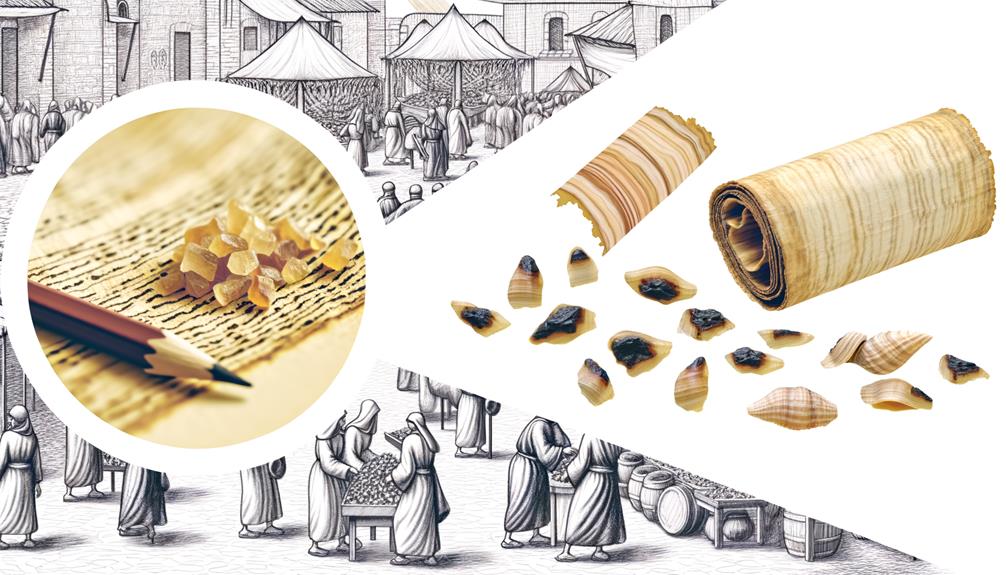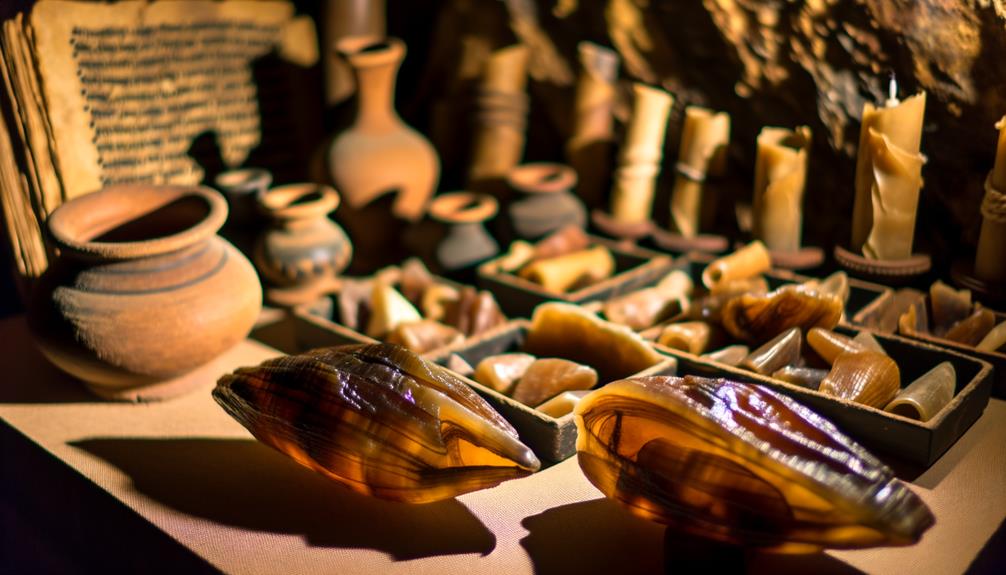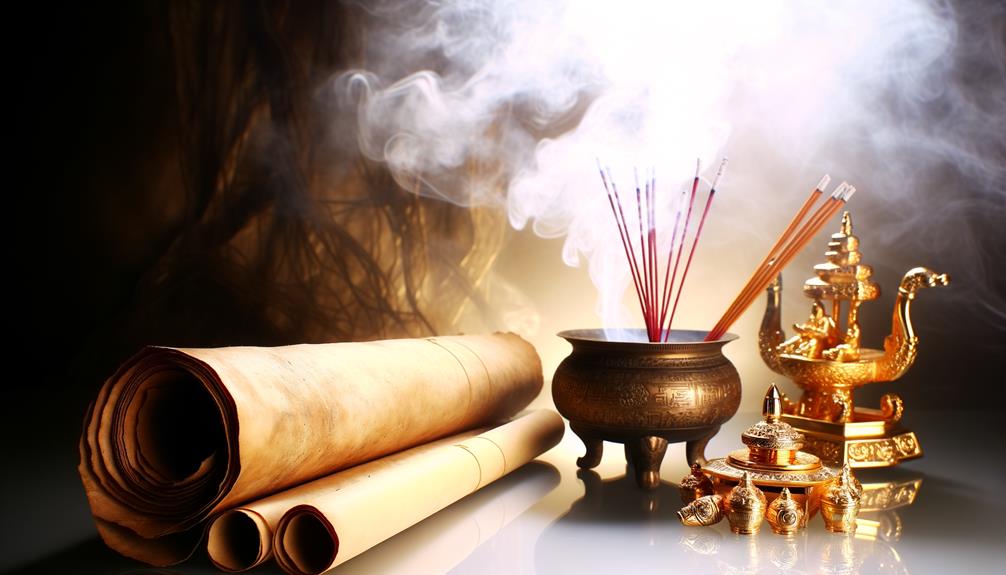Onycha Meaning in the Bible: Sacred Incense
In the Bible, onycha is mentioned in Exodus 30:34 as an essential ingredient in the sacred incense used within the Tabernacle’s rituals. This substance, derived from sea snail opercula, was critical for its aromatic properties, contributing to the spiritual atmosphere required for holy worship.
Historically, onycha’s value spanned across ancient trade, medicinal uses, and sacred rites in various cultures, indicating its broad significance. Theologically, it symbolizes spiritual purity and divine presence, elevating religious practices.
For those interested in the deeper layers of its historical importance and symbolic interpretations, further exploration reveals its extensive legacy.

Onycha Meaning in the Bible: Sacred Ingredient in Holy Incense
| Aspect | Details |
|---|---|
| Definition | A fragrant spice derived from shellfish or resin, used in holy incense |
| Biblical Reference | Exodus 30:34 – part of the sacred incense for the Tabernacle |
| Function | Contributed to the aroma of the incense offered to God |
| Symbolism | Represents prayer rising to God, purity, and sanctified worship |
| Spiritual Lesson | Emphasizes the importance of reverent, heartfelt prayer and consecration |
Biblical References to Onycha

Onycha, a substance mentioned in the Bible, appears specifically in the context of the holy incense described in Exodus 30:34. This verse lists onycha as one of the key ingredients in a sacred formula to be used exclusively in the Tabernacle.
The specific inclusion of onycha among other aromatic substances emphasizes its importance in the ritualistic practices of ancient Israel. The text underscores the sanctity and exclusivity of this incense, setting it apart for divine worship.
The precise role and nature of onycha have been subjects of scholarly debate, highlighting its enigmatic status. Nevertheless, its biblical mention signifies its integral function in creating an environment conducive to spiritual reverence and divine presence.
Historical Context of Onycha

Rooted in ancient trade routes and medicinal practices, the historical context of onycha reveals its multifaceted significance across various cultures and epochs.
In antiquity, onycha was a key component in incense, prized for its aromatic qualities and used extensively in religious rituals. Its value transcended borders, with records indicating its trade from the Arabian Peninsula to distant parts of the Mediterranean and Indian subcontinent.
Additionally, ancient medical texts highlight its purported therapeutic properties, often utilized in healing balms and ointments. The cross-cultural reverence for onycha underscores its integral role in both daily life and sacred ceremonies, reflecting a deep-seated appreciation that permeated through ancient civilizations.
This historical tapestry enriches our understanding of onycha’s enduring legacy.
Composition and Source

Building upon its historical significance, the composition and source of onycha further illuminate its revered status in ancient cultures.
Derived from the operculum of certain sea snails, onycha’s unique aromatic properties made it a prized ingredient in sacred incense. This substance was meticulously prepared to guarantee its purity and potency.
Key aspects of onycha’s composition and source include:
- Biological Origin: Onycha is obtained from the operculum of specific mollusks, primarily found in the Red Sea and Mediterranean regions.
- Preparation Process: The operculum undergoes a detailed preparation process, involving cleaning, drying, and grinding to achieve the desired aromatic qualities.
- Usage in Incense: Its inclusion in incense formulations underscores its significance in various religious practices, highlighting its enduring cultural and spiritual value.
Symbolism in Religious Rituals

In religious rituals, the symbolism of onycha extends beyond its aromatic properties, embodying spiritual purity and sanctity.
Historically, onycha formed a vital component of sacred incense in the Tabernacle, as outlined in Exodus 30:34-38. This inclusion signifies its role in creating a consecrated atmosphere, fostering a direct connection between the divine and worshippers.
The burning of onycha, combined with other sacred elements, symbolizes the ascent of prayers to heaven, enveloping them in a sanctified aura. Additionally, its deep, resonant fragrance is often interpreted as a metaphor for the pervasive presence of the divine, purifying both the space and the individuals within it.
Consequently, onycha’s symbolic importance in religious rituals underscores its profound spiritual significance.
Scholarly Interpretations

Scholarly interpretations of onycha’s significance in the Bible often explore its etymological origins, botanical identification, and the theological implications of its use in sacred practices. Scholars investigate these aspects to elucidate its role in ancient Hebrew rituals and texts.
Key areas of scholarly focus include:
- Etymological Origins: Examining the Hebrew term ‘shecheleth’ and its connections to other ancient languages to understand its initial meaning and connotations.
- Botanical Identification: Identifying the precise plant or substance referred to as onycha, often considered to be derived from certain mollusk shells or aromatic resins.
- Theological Implications: Analyzing how onycha’s inclusion in holy incense symbolizes purity and divine presence, reinforcing its sacred status.
These interpretations collectively deepen our comprehension of onycha’s biblical significance.
Onycha in Ancient Cultures

Examining onycha’s presence in ancient cultures reveals its widespread application and significance beyond the biblical context, particularly in medicinal, aromatic, and ceremonial practices.
In ancient Egypt, onycha was an essential component in the preparation of Kyphi, a complex incense blend used for religious rituals and medicinal purposes.
Similarly, Greek and Roman texts document its inclusion in therapeutic salves and ointments, highlighting its perceived healing properties.
In the broader Mesopotamian region, onycha was valued for its aromatic qualities, often burned during sacred rites.
These historical usages underscore onycha’s multifaceted role in ancient societies, where it served not only as a precious incense but also as a medicinal remedy, reflecting its extensive cultural and practical importance across various civilizations.
Modern Understanding and Relevance

In contemporary discourse, the historical context and usage of onycha provide a foundation for its symbolic interpretations today, reflecting its enduring significance.
This ancient substance, once integral to sacred incense, continues to influence modern religious and cultural practices.
Understanding its impact necessitates an exploration of how onycha’s legacy persists within different cultural contexts and its continued relevance in spiritual symbolism.
Historical Context and Usage
Understanding the historical context and usage of onycha in biblical times reveals its significant role in ancient religious practices and its evolving interpretation in modern scholarship.
Onycha, traditionally derived from the operculum of certain mollusks, was a key ingredient in the sacred incense described in Exodus 30:34. Its inclusion signifies:
- Religious Significance: Used in temple rituals, onycha was part of the incense meant to create a pleasing aroma for worship.
- Cultural Value: Onycha’s rarity and exotic origins underscored its value and importance in ancient trade networks.
- Evolving Scholarship: Modern researchers debate the precise botanical source of onycha, reflecting ongoing scholarly efforts to reconcile historical texts with archaeological findings.
Understanding these aspects highlights onycha’s enduring influence.
Symbolic Interpretations Today
Modern interpretations of onycha often explore its symbolic resonance in contemporary religious and cultural contexts, reflecting an ongoing interest in its historical and spiritual significance.
Today, onycha is frequently viewed as a symbol of prayer and divine connection, attributed to its ancient use in sacred incense. This interpretation underscores the importance placed on sensory experiences in spiritual practice, with onycha representing the elevation of prayers to the divine.
Additionally, some modern scholars link onycha to themes of purity and transformation, drawing parallels between its aromatic properties and the purification of the soul.
Consequently, onycha’s enduring relevance is maintained through its multifaceted symbolism, which continues to inspire and inform contemporary spiritual discourse.
Cultural Significance and Impact
The contemporary cultural significance of onycha is profoundly intertwined with its historical roots, perpetuating its relevance through various religious, therapeutic, and symbolic practices.
Modern interpretations continue to acknowledge onycha’s ancient uses, adapting them to fit contemporary contexts.
The following points highlight its current impact:
- Religious Practices: Onycha remains integral in the formulation of incense for religious rituals, symbolizing sanctity and spiritual elevation.
- Aromatherapy: Recognized for its soothing properties, onycha is often included in essential oil blends aimed at promoting relaxation and mental clarity.
- Symbolic Representation: Onycha’s historical and biblical importance grants it a symbolic status in literature and art, where it represents purity and divine presence.
Understanding these facets underscores onycha’s enduring relevance across cultures and disciplines.
Conclusion
Onycha, a substance mentioned in biblical texts, occupies a significant place in religious rituals and ancient cultures, suggesting a complex interplay between material composition and symbolic meaning.
Historical contexts and scholarly interpretations reveal its multifaceted role, akin to the multifaceted debates surrounding quantum computing today.
This analysis underscores the enduring relevance of onycha, bridging ancient traditions with modern inquiries into its nature and significance.
Consequently, onycha remains a compelling subject for ongoing scholarly exploration and interpretation.






